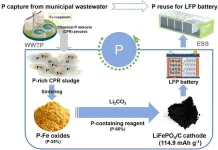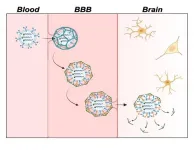New method recovers phosphorus from wastewater to power the future of lithium-iron phosphate batteries
2024-07-31
(Press-News.org)
In a recent study published in Engineering, a research team from the Shenzhen Engineering Research Laboratory for Sludge and Food Waste Treatment and Resource Recovery has introduced a pioneering method to tackle the critical global issue of phosphorus (P) scarcity. Their innovative approach leverages municipal wastewater to produce phosphorus vital for the manufacture of lithium iron phosphate (LiFePO4) batteries, a key component in the rapidly growing electric vehicle market.
As the demand for LiFePO4 batteries surges due to their application in lithium-ion batteries (LIBs), the scarcity of phosphorus has become a pressing concern. Phosphorus is essential for producing high-performance cathode materials for these batteries. The researchers have devised an environmentally friendly and cost-effective solution by recovering phosphorus from municipal wastewater, transforming it into a valuable resource for battery production.
Transforming Waste into Wealth: The New Recovery Method
The team’s novel method involves using sludge from Fe-coagulant-based chemical phosphorus removal (CPR) processes in wastewater treatment. This sludge, rich in phosphorus and iron, undergoes a sintering treatment followed by acid washing to yield purified P–Fe oxides (Fe2.1P1.0O5.6). These oxides are then utilized as a substitute for up to 35% of the FePO4 reagent typically used in synthesizing LiFePO4 cathodes.
The resulting carbon-coated LiFePO4 (LiFePO4/C) cathodes exhibit impressive performance characteristics. They achieve a specific discharge capacity of 114.9 mA·h·g−1 at 17 mA·g−1 and maintain a remarkable cycle stability of 99.2% after 100 cycles. This enhanced performance is attributed to the beneficial impurities from the sludge, which contribute to a more stable crystal structure in the cathodes.
Economic and Environmental Impact
Unlike traditional phosphorus recovery methods, which primarily produce P-fertilizers, this innovative approach converts 100% of the phosphorus from CPR sludge into high-value LiFePO4/C cathodes. This process not only addresses the global phosphorus scarcity but also offers a sustainable solution to managing urban waste.
The economic benefits are substantial. The researchers calculated that the phosphorus recovered from municipal wastewater could meet up to 35% of the phosphorus demand in China’s LIBs industry. This positions the new recovery method as a highly cost-effective alternative to conventional phosphorus reuse routes.
A Pathway to Sustainable Development
The significance of this research extends beyond just technological advancement. By converting wastewater sludge into a critical component for clean energy storage, the team’s approach supports both environmental sustainability and the global push for cleaner energy solutions. The recovery process reduces urban waste, decreases dependency on finite phosphorus resources, and contributes to the development of sustainable technologies. It provides a dual benefit of addressing phosphorus scarcity while enhancing the performance of LiFePO4 batteries, thereby supporting the transition to a more sustainable and energy-efficient future.
The paper “Green and high-yield recovery of phosphorus from municipal wastewater for LiFePO4 batteries,” authored by Yijiao Chang, Xuan Wang, Bolin Zhao, Anjie Li, Yiru Wu, Bohua Wen, Bing Li, Xiao-yan Li, Lin Lin. Full text of the open access paper: https://doi.org/10.1016/j.eng.2024.05.018. For more information about the Engineering, follow us on X (https://twitter.com/EngineeringJrnl) & like us on Facebook (https://www.facebook.com/EngineeringJrnl).
END
[Attachments] See images for this press release:

ELSE PRESS RELEASES FROM THIS DATE:
2024-07-31
SAN ANTONIO — July 31, 2024 —Southwest Research Institute will provide engineering and equipment support for advanced cryptologic technology for shipboard and airborne platforms as part of a $35.7 million contract with the U.S. Navy. The five-year contract will deliver services from June 2024 through June 2029, with the option for the U.S. Navy to add $14 million and extend the contract through 2031.
SwRI develops electronic warfare (EW) technology to detect, intercept and disrupt a range of signals on the electromagnetic spectrum, supporting efforts to thwart ...
2024-07-31
With numerous species facing extinction, an international team of researchers has proposed an innovative solution to protect the planet's biodiversity: a lunar biorepository. This concept, detailed in a recent article in the journal BioScience, is aimed at creating a passive, long-lasting storage facility for cryopreserved samples of Earth's most at-risk animal species.
Led by Dr. Mary Hagedorn of the Smithsonian's National Zoo and Conservation Biology Institute, the team envisions taking advantage of the Moon's naturally cold temperatures, particularly in permanently shadowed regions near the poles, where temperatures remain consistently below –196 degrees ...
2024-07-31
Heavy rain and flooding in Brazil in November could tell forecasters whether December, January and February in Britain will be cold and dry or mild and wet.
This is because forecasting European winter weather patterns months in advance is made simpler during years of strong El Niño or La Niña events in the tropical Pacific Ocean, a new study has found.
A strong El Nino or La Nina in the Pacific Ocean can bring big changes in temperatures, wind patterns and rainfall patterns to South America. When ...
2024-07-31
HOUSTON ― The University of Texas MD Anderson Cancer Center and collaborators are initiating a research project that will send T cells to the International Space Station (ISS) to study the effects of prolonged microgravity on cell differentiation, activation, memory and exhaustion. These results will be further analyzed on Earth to uncover signaling pathways and identify potential immune targets that can improve treatment strategies for patients with cancer and other diseases.
To accomplish this work, MD Anderson researchers ...
2024-07-31
Chameleon, led by Senior Scientist Kate Keahey from Argonne National Laboratory, has been a cornerstone of CS research and education for nearly a decade. The platform has served over 10,000 users, contributing to more than 700 research publications. Chameleon has now secured an additional $12 million in funding from the U.S. National Science Foundation (NSF) to roll out its next four-year phase. With this new funding, Chameleon will continue to innovate and support its growing community, enabling groundbreaking discoveries in CS systems research.
ABOUT CHAMELEON: A PLATFORM FOR INNOVATION
Chameleon is a large-scale, deeply reconfigurable experimental ...
2024-07-31
When performing resistance training such as lifting weights, there’s a lot of interest in how close you push yourself to failure – the point where you can’t do another rep – and how it affects your results.
While research has looked at this concept in different ways, to date, no meta-analysis has explored the pattern (i.e., linear or non-linear) of how the distance from failure (measured by repetitions in reserve) affects changes in muscle strength and size.
As such, it’s ...
2024-07-31
Neurotransmitter levels in the brain can indicate brain health and neurodegenerative diseases like Alzheimer’s. However, the protective blood-brain barrier (BBB) makes delivering fluorescent sensors that can detect these small molecules to the brain difficult. Now, researchers in ACS Central Science demonstrate a way of packaging these sensors for easy passage across the BBB in mice, allowing for improved brain imaging. With further development, the technology could help advance Alzheimer’s disease diagnosis and treatment.
It is common for neurotransmitter levels ...
2024-07-31
Millions of Americans take anticoagulants, commonly known as blood thinners. These medications work to prevent blood clots that cause heart attack and stroke.
More than two-thirds of those people take a type of blood thinner called a direct oral anticoagulant. DOACs, such as rivaroxaban (brand name Xarelto) and apixaban (brand name Eliquis), are under- or over-prescribed in up to one in eight patents.
These prescribing issues can have life threatening consequences, and they most often occur after a provider writes the initial prescription, according to a study led by Michigan Medicine.
“Direct oral anticoagulants may be viewed ...
2024-07-31
ROCHESTER, Minn. — Mayo Clinic scientists are using artificial intelligence (AI) and machine learning to analyze electroencephalogram (EEG) tests more quickly and precisely, enabling neurologists to find early signs of dementia among data that typically go unexamined.
The century-old EEG, during which a dozen or more electrodes are stuck to the scalp to monitor brain activity, is often used to detect epilepsy. Its results are interpreted by neurologists and other experts trained to spot patterns among the test's squiggly waves.
In new research published in Brain Communications, scientists at the Mayo Clinic Neurology AI Program (NAIP) demonstrate ...
2024-07-31
According to a World Health Organization (WHO) study (2017), about half of all infertility is due to men. Semen analysis is considered essential for diagnosis of male infertility, but is not readily available at medical institutions other than those specializing in infertility treatment, and there is a high threshold for receiving it.
In this study, a group led by Associate Professor Hideyuki Kobayashi of the Department of Urology, Toho University School of Medicine, Tokyo, Japan developed an AI model that can predict the risk ...
LAST 30 PRESS RELEASES:
[Press-News.org] New method recovers phosphorus from wastewater to power the future of lithium-iron phosphate batteries





